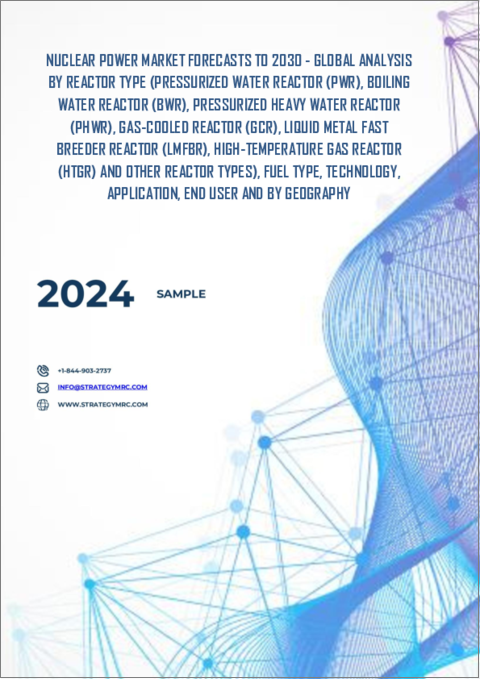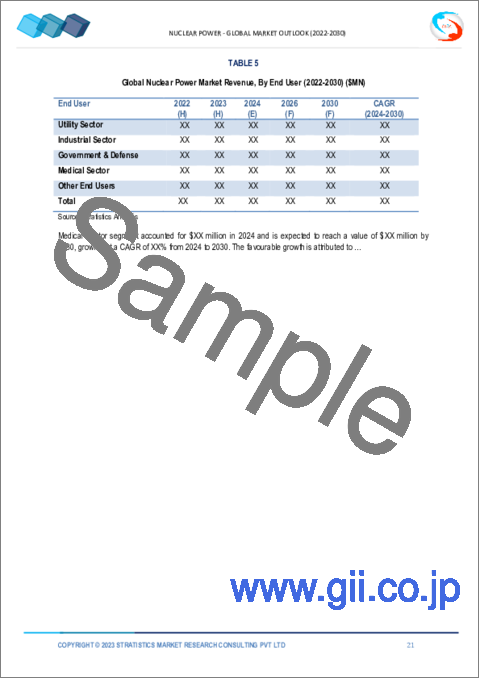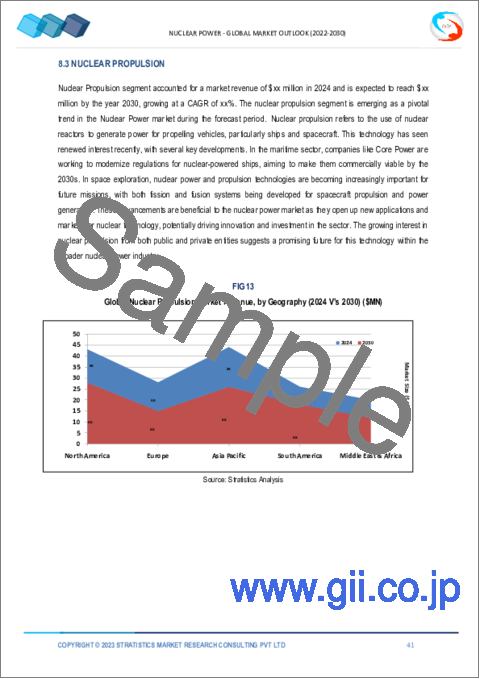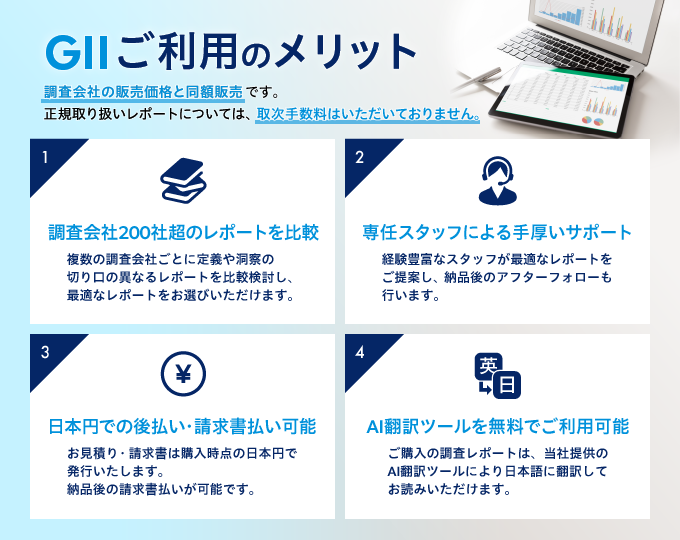|
|
市場調査レポート
商品コード
1530820
原子力発電市場の2030年までの予測:原子炉タイプ、燃料タイプ、技術、用途、エンドユーザー、地域別の世界分析Nuclear Power Market Forecasts to 2030 - Global Analysis By Reactor Type, Fuel Type, Technology, Application, End User and By Geography |
||||||
カスタマイズ可能
|
|||||||
| 原子力発電市場の2030年までの予測:原子炉タイプ、燃料タイプ、技術、用途、エンドユーザー、地域別の世界分析 |
|
出版日: 2024年08月01日
発行: Stratistics Market Research Consulting
ページ情報: 英文 200+ Pages
納期: 2~3営業日
|
全表示
- 概要
- 図表
- 目次
Stratistics MRCによると、世界の原子力発電市場は2024年に868億1,000万米ドルを占め、予測期間中のCAGRは4.8%で成長し、2030年には1,052億7,000万米ドルに達する見込みです。
原子力発電は、核分裂を中心とする核反応によって生成されるエネルギーであり、原子核が分裂することで大量のエネルギーが放出されます。このエネルギーが水を加熱して蒸気を発生させ、その蒸気が発電機に接続されたタービンを動かして電気を生産します。原子力は低炭素エネルギー源であり、大規模で安定した電力を供給できます。この技術は、化石燃料への依存を減らすことができるため、持続可能なエネルギーに関する議論の中心となっています。
原子力省によると、インド政府は2023年4月、インド全土の5つの州に10基の原子炉を設置する認可と財政承認を与えました。
経済と人口の拡大
経済の拡大と人口の増加はエネルギー需要を増大させ、信頼性の高い大規模発電の必要性を促します。安定した高出力の電力を供給できる原子力は、こうした需要を満たすための重要なソリューションとなります。各国が工業的発展を遂げ都市化するにつれ、経済成長とインフラ整備の必要性を支える安定した低炭素エネルギー源を求めるようになります。温室効果ガスの排出を最小限に抑えながら大量のエネルギーを供給する原子力の能力は、こうした目標に合致しており、その採用と市場成長を後押ししています。
放射性廃棄物管理
核廃棄物管理は、原子力発電から生じる放射性製品別の長期貯蔵と処分に対処するために必要です。この廃棄物は何千年もの間、有害なままであり、安全で安定した、環境的に安全な封じ込めが必要です。廃棄物の貯蔵・処分に関連する社会的懸念や規制上の課題は、遅延や費用の増加につながり、最終的には原子力発電投資の実現可能性や魅力に影響を及ぼす可能性があります。そのため、複雑さと高コストは原子力発電市場の成長を大きく妨げる可能性があります。
支援的規制とインセンティブ
政府は、原子炉の建設と運転に関連する高額の資本コストを削減するため、原子力プロジェクトに補助金、減税、財政支援を提供することが多いです。承認プロセスを合理化し、イノベーションを奨励しながら安全を確保する規制枠組みは、市場拡大をさらに促進します。さらに、炭素削減目標に対する長期的なコミットメントが、原子力のような低排出エネルギー源に対する需要を促進しています。これらの措置は総体的に、持続可能なエネルギー・ミックスの重要な構成要素としての原子力の経済的実行可能性と魅力を高めています。
高い資本コスト
原子力発電における高い資本コストは、高価な原子炉の建設、厳格な安全要件、および複雑な規制遵守から生じる。先進技術、長いプロジェクト期間、厳格な安全プロトコルに必要な多額の投資が、こうしたコストの一因となっています。これは、将来のエネルギー需要を満たす上での役割に影響を与えます。こうした財政的障壁は、潜在的な投資家を遠ざけ、プロジェクト開始を遅らせ、全体的なエネルギーコストを上昇させることにより、市場の成長を妨げる可能性があります。
COVID-19の影響
COVID-19パンデミックは、プロジェクトの遅延、サプライチェーンの混乱、労働力不足を通じて原子力発電市場に影響を与え、新規原子炉の建設と保守を遅らせた。エネルギー需要の変動と経済の不確実性も投資決定に影響を与えました。しかし、パンデミックは、信頼性の高い低炭素エネルギー源の必要性を浮き彫りにし、安定したエネルギー選択肢としての原子力に対する長期的関心を高める可能性があります。政府と企業は、パンデミック後の回復段階において、エネルギー安全保障と持続可能性を高めるために原子力エネルギーへの注力を強める可能性があります。
予測期間中、発電部門が最大となる見込み
発電分野は有利な成長を遂げると推定されます。発電において原子力は、核反応を利用して熱を発生させ、タービンを駆動して電気を生産するための蒸気を発生させることにより、安定した大規模なエネルギー源を提供します。高い発電容量と信頼性の高い出力を提供するため、送電網の安定性を維持し、化石燃料への依存度を下げる上で重要な役割を担っています。原子力発電は、増大する世界のエネルギー需要に対応するため、低炭素で安定した発電を目指すエネルギー戦略にとって、依然として重要な要素です。
予測期間中にCAGRが最も高くなると予想される産業用セグメント
予測期間中、CAGRが最も高くなると予想されるのは産業部門です。産業部門では、原子力は主に大規模な操業を支えるための発電に利用されます。原子力は、化学製造、鉄鋼生産、鉱業などエネルギー需要の高い産業にとって不可欠な、安定した信頼性の高いエネルギー供給を提供します。原子力の安定性と低炭素排出量は、継続的かつ効率的なエネルギー生産を確保しながら環境フットプリントの削減を目指す産業にとって、貴重な資産となっています。
最大のシェアを占める地域:
予測期間中、アジア太平洋地域が最大の市場シェアを占めると予測されます。アジア太平洋地域は、中国、インド、日本などの国々が牽引する世界の原子力発電市場の主要プレーヤーです。中国とインドは、増大するエネルギー需要を満たし、二酸化炭素排出量を削減するために原子力能力を拡大しており、多数の新しい原子炉が建設中です。日本は、安全性と規制の改善に重点を置きながら、福島事故後の原子力部門の復活に取り組んでいます。この地域の原子力への投資は、経済と環境に対する圧力が高まる中、持続可能で信頼できるエネルギー源への戦略的シフトを反映しています。
CAGRが最も高い地域:
予測期間中、北米のCAGRが最も高くなると予測されます。この地域の原子力発電市場は大きく、米国とカナダが原子炉の数と容量でリードしています。米国は世界最大の商業用原子炉群を運転し、既存施設の維持とアップグレードに注力しています。カナダは、低炭素の利点から原子力を重視し、小型モジュール炉(SMR)のような新技術を開発しています。両国は、エネルギー安全保障を確保し気候変動に対処するために原子力への投資を続けており、それによって市場の成長を促進しています。
無料のカスタマイズサービス:
本レポートをご購読のお客様には、以下の無料カスタマイズオプションのいずれかをご利用いただけます:
- 企業プロファイル
- 追加市場プレイヤーの包括的プロファイリング(3社まで)
- 主要企業のSWOT分析(3社まで)
- 地域セグメンテーション
- 顧客の関心に応じた主要国の市場推計・予測・CAGR(注:フィージビリティチェックによる)
- 競合ベンチマーキング
- 製品ポートフォリオ、地理的プレゼンス、戦略的提携に基づく主要企業のベンチマーキング
目次
第1章 エグゼクティブサマリー
第2章 序文
- 概要
- ステークホルダー
- 調査範囲
- 調査手法
- データマイニング
- データ分析
- データ検証
- 調査アプローチ
- 調査情報源
- 1次調査情報源
- 2次調査情報源
- 前提条件
第3章 市場動向分析
- 促進要因
- 抑制要因
- 機会
- 脅威
- 技術分析
- 用途分析
- エンドユーザー分析
- 新興市場
- COVID-19の影響
第4章 ポーターのファイブフォース分析
- 供給企業の交渉力
- 買い手の交渉力
- 代替品の脅威
- 新規参入業者の脅威
- 競争企業間の敵対関係
第5章 世界の原子力発電市場:原子炉タイプ別
- 加圧水型原子炉(PWR)
- 沸騰水型原子炉(BWR)
- 加圧重水炉(PHWR)
- ガス冷却炉(GCR)
- 液体金属高速増殖炉(LMFBR)
- 高温ガス炉(HTGR)
- その他の原子炉の種類
第6章 世界の原子力発電市場:燃料タイプ別
- ウラン燃料
- プルトニウム燃料
- トリウム燃料
- 混合酸化物燃料(MOX)
- その他の燃料タイプ
第7章 世界の原子力市場:技術別
- 先進炉
- 小型モジュール炉(SMR)
- 第3世代および第3世代+原子炉
- 第4世代原子炉
- その他のテクノロジー
第8章 世界の原子力発電市場:用途別
- 発電
- 原子力推進
- 淡水化
- 建設と検査
- その他の用途
第9章 世界の原子力市場:エンドユーザー別
- 公益事業部門
- 産業部門
- 政府と防衛
- 医療分野
- その他のエンドユーザー
第10章 世界の原子力市場:地域別
- 北米
- 米国
- カナダ
- メキシコ
- 欧州
- ドイツ
- 英国
- イタリア
- フランス
- スペイン
- その他欧州
- アジア太平洋
- 日本
- 中国
- インド
- オーストラリア
- ニュージーランド
- 韓国
- その他アジア太平洋地域
- 南米
- アルゼンチン
- ブラジル
- チリ
- その他南米
- 中東・アフリカ
- サウジアラビア
- アラブ首長国連邦
- カタール
- 南アフリカ
- その他中東とアフリカ
第11章 主な発展
- 契約、パートナーシップ、コラボレーション、合弁事業
- 買収と合併
- 新製品発売
- 事業拡大
- その他の主要戦略
第12章 企業プロファイリング
- Areva Corporation
- Toshiba Corporation
- GE Hitachi Nuclear Energy(GEH)
- Mitsubishi Heavy Industries
- Siemens
- Exelon Generation
- Korea Electric Power Corporation(KEPCO)
- China National Nuclear Corporation(CNNC)
- China General Nuclear Power Group(CGN)
- Westinghouse Electric Company
- Babcock & Wilcox
- Holtec International
- Rosatom
- EDF Energy
- Framatome
- Nuclear Fuel Services, Inc.
- Cameco Corporation
- BWX Technologies
List of Tables
- Table 1 Global Nuclear Power Market Outlook, By Region (2022-2030) ($MN)
- Table 2 Global Nuclear Power Market Outlook, By Reactor Type (2022-2030) ($MN)
- Table 3 Global Nuclear Power Market Outlook, By Pressurized Water Reactor (PWR) (2022-2030) ($MN)
- Table 4 Global Nuclear Power Market Outlook, By Boiling Water Reactor (BWR) (2022-2030) ($MN)
- Table 5 Global Nuclear Power Market Outlook, By Pressurized Heavy Water Reactor (PHWR) (2022-2030) ($MN)
- Table 6 Global Nuclear Power Market Outlook, By Gas-cooled Reactor (GCR) (2022-2030) ($MN)
- Table 7 Global Nuclear Power Market Outlook, By Liquid Metal Fast Breeder Reactor (LMFBR) (2022-2030) ($MN)
- Table 8 Global Nuclear Power Market Outlook, By High-Temperature Gas Reactor (HTGR) (2022-2030) ($MN)
- Table 9 Global Nuclear Power Market Outlook, By Other Reactor Types (2022-2030) ($MN)
- Table 10 Global Nuclear Power Market Outlook, By Fuel Type (2022-2030) ($MN)
- Table 11 Global Nuclear Power Market Outlook, By Uranium Fuel (2022-2030) ($MN)
- Table 12 Global Nuclear Power Market Outlook, By Plutonium Fuel (2022-2030) ($MN)
- Table 13 Global Nuclear Power Market Outlook, By Thorium Fuel (2022-2030) ($MN)
- Table 14 Global Nuclear Power Market Outlook, By Mixed Oxide Fuel (MOX) (2022-2030) ($MN)
- Table 15 Global Nuclear Power Market Outlook, By Other Fuel Types (2022-2030) ($MN)
- Table 16 Global Nuclear Power Market Outlook, By Technology (2022-2030) ($MN)
- Table 17 Global Nuclear Power Market Outlook, By Advanced Reactors (2022-2030) ($MN)
- Table 18 Global Nuclear Power Market Outlook, By Small Modular Reactors (SMR) (2022-2030) ($MN)
- Table 19 Global Nuclear Power Market Outlook, By Generation III & III+ Reactors (2022-2030) ($MN)
- Table 20 Global Nuclear Power Market Outlook, By Generation IV Reactors (2022-2030) ($MN)
- Table 21 Global Nuclear Power Market Outlook, By Other Technologies (2022-2030) ($MN)
- Table 22 Global Nuclear Power Market Outlook, By Application (2022-2030) ($MN)
- Table 23 Global Nuclear Power Market Outlook, By Power Generation (2022-2030) ($MN)
- Table 24 Global Nuclear Power Market Outlook, By Nuclear Propulsion (2022-2030) ($MN)
- Table 25 Global Nuclear Power Market Outlook, By Desalination (2022-2030) ($MN)
- Table 26 Global Nuclear Power Market Outlook, By Research & Testing (2022-2030) ($MN)
- Table 27 Global Nuclear Power Market Outlook, By Other Applications (2022-2030) ($MN)
- Table 28 Global Nuclear Power Market Outlook, By End User (2022-2030) ($MN)
- Table 29 Global Nuclear Power Market Outlook, By Utility Sector (2022-2030) ($MN)
- Table 30 Global Nuclear Power Market Outlook, By Industrial Sector (2022-2030) ($MN)
- Table 31 Global Nuclear Power Market Outlook, By Government & Defense (2022-2030) ($MN)
- Table 32 Global Nuclear Power Market Outlook, By Medical Sector (2022-2030) ($MN)
- Table 33 Global Nuclear Power Market Outlook, By Other End Users (2022-2030) ($MN)
Note: Tables for North America, Europe, APAC, South America, and Middle East & Africa Regions are also represented in the same manner as above.
According to Stratistics MRC, the Global Nuclear Power Market is accounted for $86.81 billion in 2024 and is expected to reach $105.27 billion by 2030 growing at a CAGR of 4.8% during the forecast period. Nuclear power is the energy produced through nuclear reactions, primarily fission, where atomic nuclei split into smaller parts, releasing a significant amount of energy. This energy heats water to produce steam, which drives turbines connected to generators, producing electricity. Nuclear power is a low-carbon energy source and can provide large-scale, consistent power. The technology is central to discussions on sustainable energy due to its capacity to reduce reliance on fossil fuels.
According to the Atomic Energy Ministry, in April 2023, the Indian government granted authorization and financial approval for establishing ten nuclear reactors in five different states throughout India.
Market Dynamics:
Driver:
Expanding economies and population
Expanding economies and growing populations increase energy demand, driving the need for reliable, large-scale power generation. Nuclear power, with its ability to provide consistent and high-output electricity, becomes a crucial solution for meeting these demands. As countries develop industrially and urbanize, they seek stable and low-carbon energy sources to support economic growth and infrastructure needs. Nuclear power's capacity to deliver large amounts of energy with minimal greenhouse gas emissions aligns with these goals, propelling its adoption and market growth.
Restraint:
Nuclear waste management
Nuclear waste management is necessary to address the long-term storage and disposal of radioactive by-products from nuclear power generation. This waste remains hazardous for thousands of years, requiring secure, stable, and environmentally safe containment. Public concerns and regulatory challenges related to waste storage and disposal can lead to delays and increased expenses, ultimately affecting the feasibility and attractiveness of nuclear power investments. The complexity and high costs therefore can significantly hamper nuclear power market growth.
Opportunity:
Supportive regulations and incentives
Governments often provide subsidies, tax breaks, and financial support for nuclear projects, reducing the high capital costs associated with reactor construction and operation. Regulatory frameworks that streamline approval processes and ensure safety while encouraging innovation further facilitate market expansion. Additionally, long-term commitments to carbon reduction targets drive demand for low-emission energy sources like nuclear power. These measures collectively enhance the economic viability and attractiveness of nuclear energy as a key component of a sustainable energy mix.
Threat:
High capital costs
High capital costs in nuclear power arise from the expensive construction of reactors, stringent safety requirements, and complex regulatory compliance. The significant investment needed for advanced technologies, long project timelines, and rigorous safety protocols contribute to these costs. This impacts its role in meeting future energy demands. These financial barriers can hamper market growth by deterring potential investors, delaying project initiation, and increasing overall energy costs.
Covid-19 Impact
The covid-19 pandemic impacted the nuclear power market through project delays, supply chain disruptions, and workforce shortages, slowing new reactor construction and maintenance. Energy demand fluctuations and economic uncertainties also affected investment decisions. However, the pandemic highlighted the need for reliable, low-carbon energy sources, potentially boosting long-term interest in nuclear power as a stable energy option. Governments and companies may increase focus on nuclear energy to enhance energy security and sustainability in the post-pandemic recovery phase.
The power generation segment is expected to be the largest during the forecast period
The power generation segment is estimated to have a lucrative growth. In power generation, nuclear power provides a stable and large-scale energy source by using nuclear reactions to produce heat, which generates steam to drive turbines and produce electricity. It offers high capacity factors and reliable output, making it a key player in maintaining grid stability and reducing reliance on fossil fuels. Nuclear power remains a critical component of energy strategies aiming for low-carbon and consistent power generation to meet growing global energy demands.
The industrial segment is expected to have the highest CAGR during the forecast period
The industrial segment is anticipated to witness the highest CAGR growth during the forecast period. In the industrial sector, nuclear power is utilized primarily for generating electricity to support large-scale operations. It provides a steady and reliable energy supply, essential for industries with high energy demands such as chemical manufacturing, steel production, and mining. The stability and low carbon emissions of nuclear power make it a valuable asset for industries aiming to reduce their environmental footprint while ensuring continuous, efficient energy production.
Region with largest share:
Asia Pacific is projected to hold the largest market share during the forecast period. The Asia-Pacific region is a major player in the global nuclear power market, driven by countries like China, India, and Japan. China and India are expanding their nuclear capacities to meet growing energy demands and reduce carbon emissions, with numerous new reactors under construction. Japan is working to revive its nuclear sector post-Fukushima, focusing on safety and regulatory improvements. The region's investment in nuclear power reflects a strategic shift toward sustainable and reliable energy sources amid rising economic and environmental pressures.
Region with highest CAGR:
North America is projected to have the highest CAGR over the forecast period. The nuclear power market in the region is significant, with the United States and Canada leading in reactor numbers and capacity. The U.S. operates the largest fleet of commercial nuclear reactors globally, focusing on maintaining and upgrading existing facilities. Canada emphasizes nuclear energy for its low-carbon benefits and is developing new technologies like Small Modular Reactors (SMRs). Both countries continue to invest in nuclear power to ensure energy security and address climate change, thereby propelling the market growth.
Key players in the market
Some of the key players profiled in the Nuclear Power Market include Areva Corporation, Toshiba Corporation, GE Hitachi Nuclear Energy (GEH), Mitsubishi Heavy Industries, Siemens, Exelon Generation, Korea Electric Power Corporation (KEPCO), China National Nuclear Corporation (CNNC), China General Nuclear Power Group (CGN), Westinghouse Electric Company, Babcock & Wilcox, Holtec International, Rosatom, EDF Energy, Framatome, Nuclear Fuel Services, Inc., Cameco Corporation and BWX Technologies.
Key Developments:
In May 2024, Toshiba and Local Manufacturers in Poland collaborated for supply of equipment and maintenance services to country's first nuclear power plant. This collaboration helps transfer advanced nuclear technology and expertise to Poland, enhancing the country's capability to operate and maintain nuclear power plants.
In April 2024, GE Hitachi Nuclear Energy (GEH) has launched a new supplier group to support the deployment of Small Modular Reactors (SMRs). This initiative is part of GEH's broader strategy to advance the adoption of SMR technology, which is seen as a key solution for expanding nuclear power's role in clean energy production.
Reactor Types Covered:
- Pressurized Water Reactor (PWR)
- Boiling Water Reactor (BWR)
- Pressurized Heavy Water Reactor (PHWR)
- Gas-cooled Reactor (GCR)
- Liquid Metal Fast Breeder Reactor (LMFBR)
- High-Temperature Gas Reactor (HTGR)
- Other Reactor Types
Fuel Types Covered:
- Uranium Fuel
- Plutonium Fuel
- Thorium Fuel
- Mixed Oxide Fuel (MOX)
- Other Fuel Types
Technologies Covered:
- Advanced Reactors
- Small Modular Reactors (SMR)
- Generation III & III+ Reactors
- Generation IV Reactors
- Other Technologies
Applications Covered:
- Power Generation
- Nuclear Propulsion
- Desalination
- Research & Testing
- Other Applications
End Users Covered:
- Utility Sector
- Industrial Sector
- Government & Defense
- Medical Sector
- Other End Users
Regions Covered:
- North America
- US
- Canada
- Mexico
- Europe
- Germany
- UK
- Italy
- France
- Spain
- Rest of Europe
- Asia Pacific
- Japan
- China
- India
- Australia
- New Zealand
- South Korea
- Rest of Asia Pacific
- South America
- Argentina
- Brazil
- Chile
- Rest of South America
- Middle East & Africa
- Saudi Arabia
- UAE
- Qatar
- South Africa
- Rest of Middle East & Africa
What our report offers:
- Market share assessments for the regional and country-level segments
- Strategic recommendations for the new entrants
- Covers Market data for the years 2022, 2023, 2024, 2026, and 2030
- Market Trends (Drivers, Constraints, Opportunities, Threats, Challenges, Investment Opportunities, and recommendations)
- Strategic recommendations in key business segments based on the market estimations
- Competitive landscaping mapping the key common trends
- Company profiling with detailed strategies, financials, and recent developments
- Supply chain trends mapping the latest technological advancements
Free Customization Offerings:
All the customers of this report will be entitled to receive one of the following free customization options:
- Company Profiling
- Comprehensive profiling of additional market players (up to 3)
- SWOT Analysis of key players (up to 3)
- Regional Segmentation
- Market estimations, Forecasts and CAGR of any prominent country as per the client's interest (Note: Depends on feasibility check)
- Competitive Benchmarking
- Benchmarking of key players based on product portfolio, geographical presence, and strategic alliances
Table of Contents
1 Executive Summary
2 Preface
- 2.1 Abstract
- 2.2 Stake Holders
- 2.3 Research Scope
- 2.4 Research Methodology
- 2.4.1 Data Mining
- 2.4.2 Data Analysis
- 2.4.3 Data Validation
- 2.4.4 Research Approach
- 2.5 Research Sources
- 2.5.1 Primary Research Sources
- 2.5.2 Secondary Research Sources
- 2.5.3 Assumptions
3 Market Trend Analysis
- 3.1 Introduction
- 3.2 Drivers
- 3.3 Restraints
- 3.4 Opportunities
- 3.5 Threats
- 3.6 Technology Analysis
- 3.7 Application Analysis
- 3.8 End User Analysis
- 3.9 Emerging Markets
- 3.10 Impact of Covid-19
4 Porters Five Force Analysis
- 4.1 Bargaining power of suppliers
- 4.2 Bargaining power of buyers
- 4.3 Threat of substitutes
- 4.4 Threat of new entrants
- 4.5 Competitive rivalry
5 Global Nuclear Power Market, By Reactor Type
- 5.1 Introduction
- 5.2 Pressurized Water Reactor (PWR)
- 5.3 Boiling Water Reactor (BWR)
- 5.4 Pressurized Heavy Water Reactor (PHWR)
- 5.5 Gas-cooled Reactor (GCR)
- 5.6 Liquid Metal Fast Breeder Reactor (LMFBR)
- 5.7 High-Temperature Gas Reactor (HTGR)
- 5.8 Other Reactor Types
6 Global Nuclear Power Market, By Fuel Type
- 6.1 Introduction
- 6.2 Uranium Fuel
- 6.3 Plutonium Fuel
- 6.4 Thorium Fuel
- 6.5 Mixed Oxide Fuel (MOX)
- 6.6 Other Fuel Types
7 Global Nuclear Power Market, By Technology
- 7.1 Introduction
- 7.2 Advanced Reactors
- 7.3 Small Modular Reactors (SMR)
- 7.4 Generation III & III+ Reactors
- 7.5 Generation IV Reactors
- 7.6 Other Technologies
8 Global Nuclear Power Market, By Application
- 8.1 Introduction
- 8.2 Power Generation
- 8.3 Nuclear Propulsion
- 8.4 Desalination
- 8.5 Research & Testing
- 8.6 Other Applications
9 Global Nuclear Power Market, By End User
- 9.1 Introduction
- 9.2 Utility Sector
- 9.3 Industrial Sector
- 9.4 Government & Defense
- 9.5 Medical Sector
- 9.6 Other End Users
10 Global Nuclear Power Market, By Geography
- 10.1 Introduction
- 10.2 North America
- 10.2.1 US
- 10.2.2 Canada
- 10.2.3 Mexico
- 10.3 Europe
- 10.3.1 Germany
- 10.3.2 UK
- 10.3.3 Italy
- 10.3.4 France
- 10.3.5 Spain
- 10.3.6 Rest of Europe
- 10.4 Asia Pacific
- 10.4.1 Japan
- 10.4.2 China
- 10.4.3 India
- 10.4.4 Australia
- 10.4.5 New Zealand
- 10.4.6 South Korea
- 10.4.7 Rest of Asia Pacific
- 10.5 South America
- 10.5.1 Argentina
- 10.5.2 Brazil
- 10.5.3 Chile
- 10.5.4 Rest of South America
- 10.6 Middle East & Africa
- 10.6.1 Saudi Arabia
- 10.6.2 UAE
- 10.6.3 Qatar
- 10.6.4 South Africa
- 10.6.5 Rest of Middle East & Africa
11 Key Developments
- 11.1 Agreements, Partnerships, Collaborations and Joint Ventures
- 11.2 Acquisitions & Mergers
- 11.3 New Product Launch
- 11.4 Expansions
- 11.5 Other Key Strategies
12 Company Profiling
- 12.1 Areva Corporation
- 12.2 Toshiba Corporation
- 12.3 GE Hitachi Nuclear Energy (GEH)
- 12.4 Mitsubishi Heavy Industries
- 12.5 Siemens
- 12.6 Exelon Generation
- 12.7 Korea Electric Power Corporation (KEPCO)
- 12.8 China National Nuclear Corporation (CNNC)
- 12.9 China General Nuclear Power Group (CGN)
- 12.10 Westinghouse Electric Company
- 12.11 Babcock & Wilcox
- 12.12 Holtec International
- 12.13 Rosatom
- 12.14 EDF Energy
- 12.15 Framatome
- 12.16 Nuclear Fuel Services, Inc.
- 12.17 Cameco Corporation
- 12.18 BWX Technologies





